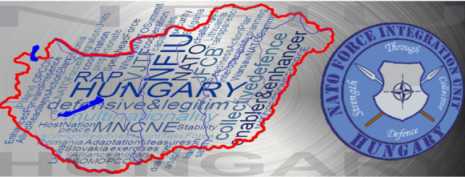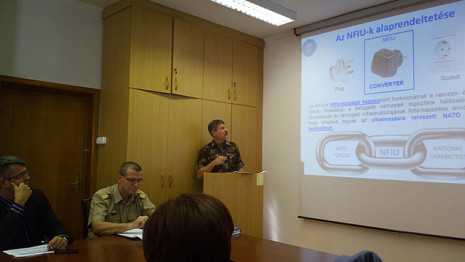After Activation, Before Inauguration
Szöveg: László Szűcs | 2016. október 18. 9:00On 1 September 2016, the Hungarian NATO Force Integration Unit (NFIU) was activated as Hungary’s first command and control element in NATO’s force structure. But what is exactly the role of this Székesfehérvár-based unit operating as a NATO international military headquarters?

In order to understand the activity of the Hungarian NFIU, let us turn back to the beginnings. At the NATO Wales Summit in 2014, the participants made a decision about enhancing the ability of the Alliance to effectively reinforce the defence of member states and provide them with more significant resources. To this end, they approved the Readiness Action Plan (RAP), which has several elements. Of these, enhancing the responsiveness of the NATO Response Force (NRF) is particularly important. The spearhead unit of the NRF is the Very High Readiness Joint Task Force (VJTF), with elements ready to deploy in 48 hours in the area of those NATO member states where the threat level necessitates their use.
The North Atlantic Alliance is also well aware that if this Very High Readiness Joint Task Force must deploy, the first few days will be of key importance in harmonizing the tasks of its activation. For this reason, also as part of the Readiness Action Plan, it has set up NATO Force Integration Units (NFIUs) in eight countries, including Hungary.

Colonel László Garas
Hungary officially initiated the establishment of a Hungarian NFIU on 17 February 2015, and subsequently the North Atlantic Council approved this request on 28 August. Col. László Garas, the appointed commander of the unit, had been chief of the Land Forces Operations and Training Directorate at the HDF Joint Force Command. The organization moved to its temporary headquarters, a building of the Alba Regia barracks, Székesfehérvár in this May. At the same time, the refurbishment of the permanent headquarters started in the neighboring Nagysándor József barracks.
The NFIUs are approx. 40-strong military organizations whose posts are filled by soldiers nominated by the host nation and the other member countries. The Hungarian NFIU will have 24 Hungarian and 18 foreign soldiers serving on its staff. The first foreign soldier, Spanish Maj. Alberto Gonzalez arrived in Székesfehérvár on 1 July, and the filling of other posts is in progress.

The primary mission of the Hungarian NFIU is to assist the movement of NATO forces and their rapid and effective deployment, and to support the planning of collective defence. Besides, in peacetime it plays an important role in arranging and conducting exercises of NATO forces in Hungary that are connected to the NFIU task scheme regarding their character and scale. Another important task of the unit is to support the reception, staging and onward movement (RSOM) of the NATO Very High Readiness Task Force and the Follow-on Force. It is worth mentioning that in spite of the foregoing, the Hungarian NFIU is not a logistic command, but rather it is structured in a way that it covers all fields of staff functions complemented with special tasks. In fact, it works like the “big NATO commands", except that it has a lower manning level and limited scope.
After its activation on 1 September, the next important milestone in the history of the Hungarian NFIU will be 18 November, the inauguration ceremony of its new building. The unit has to reach NATO Initial Operational Capability (IOC) by 1 January 2017, and Full Operational Capability (FOC) by 1 June. Between these two dates, the personnel of the NFIU will participate in a validation exercise where Hungarian and NATO experts check whether the unit is ready for task execution.

Graphic design of the NFIU building
Photos: archives